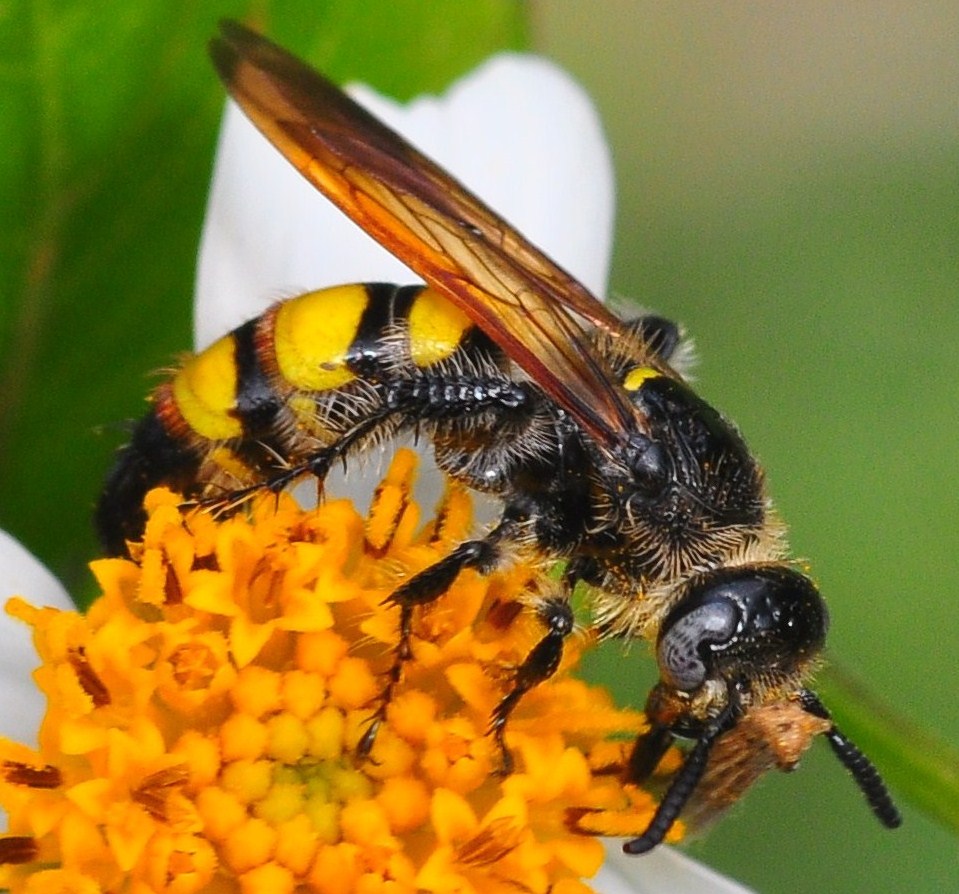[mappress]
WILDLIFE PHOTOGRAPHY – ENCHANTED FOREST PARK, FL
Yellowjacket, yellow jacket or yellow-jacket is the common name in North America for predatory wasps of the genera Vespula and Dolichovespula. Members of these genera are known simply as “wasps” in other English-speaking countries. Most of these are black-and-yellow; some are black-and-white (such as the bald-faced hornet, Dolichovespula maculata), while others may have the abdomen background color red instead of black. They can be identified by their distinctive markings, small size (similar to a honey bee), their occurrence only in colonies, and a characteristic, rapid, side to side flight pattern prior to landing. All females are capable of stinging which can cause pain to the person who has been stung. Yellowjackets are important predators of pest insects.
Yellowjackets have sometimes been mistakenly called “bees”, but they are actually in the “wasp” family. A typical yellowjacket worker is about 12 mm (0.5 in) long, with alternating bands on the abdomen while the queen is larger, about 19 mm (0.75 in) long (the different patterns on the abdomen help separate various species). Workers are sometimes confused with honey bees, especially when flying in and out of their nests. Yellowjackets, in contrast to honey bees, are not covered with tan-brown dense hair on their bodies and lack the flattened hairy hind legs used to carry pollen. They have a lance-like stinger with small barbs and typically sting repeatedly, though occasionally the stinger becomes lodged and pulls free of the wasp’s body; the venom, like most bee/wasp venoms, is primarily only dangerous to those who are allergic, unless a victim receives a large number of stings (main article: Bee sting). All species have yellow or white on the face. Mouthparts are well-developed with strong jaws called mandibles for capturing and chewing insects, with a proboscis for sucking nectar, fruit, and other juices. Nests are built in trees, shrubs, or in protected places such as inside human-made structures (attics, hollow walls or flooring, in sheds, under porches, and eaves of houses), or in soil cavities, mouse burrows, etc. Nests are made from wood fiber chewed into a paper-like pulp.
Due to their aggressive behavior, including stinging, many other insects exhibit mimicry of yellowjackets; in addition to numerous bees and wasps (Müllerian mimicry), the list includes some flies, moths, and beetles (Batesian mimicry).
Yellowjackets are social hunters living in colonies containing workers, queens, and males. Colonies are annual with only inseminated queens overwintering. Fertilized queens occur in protected places such as hollow logs, in stumps, under bark, in leaf litter, in soil cavities, and human-made structures. Queens emerge during the warm days of late spring or early summer, select a nest site, and build a small paper nest in which eggs are laid. After eggs hatch from the 30 to 50 brood cells, the queen feeds the young larvae for about 18 to 20 days. After the queen is finished taking care of them, the workers in the colony will take over caring for the larvae. Workers will chew up the food, meat or fruit, and feed it to the larvae. This act is called trophallaxis. Larvae pupate, emerging later as small, infertile females called workers. By mid-summer, the first adult workers emerge and assume the tasks of nest expansion, foraging for food, care of the queen and larvae, and colony defense.

Each fall I feed these wasps with split grapes, bruised apple slices, and maple syrup on the railing of my deck, and often have 50 or more of them buzzing around inches away as I read. Very entertaining at times. All will be calmly feeding, then one will get agitated, which sets them all off, with multiple attacks and dive-bombing. Soon, the chaos winds down into another peaceful interlude. Etc.
It’s not being brave, it’s knowing they won’t sting if I don’t threaten them. I’ve been stung once doing this.
Thanx Charles
You’re a braver man than I
I was about 2″ from it taking the shot … and I have been stung. I feel safer with bees
I meant to say “I’ve not been stung once doing this.”
when I opened this, my eye swelled up, great shot "Ento-Boy"
Thanx Hesh, I took the shot about 2" from the wasp…then ran about 50' away! lolEnto-Boy! Wasn't he one of the Marvel Super Heroes
Thanx Hesh, I took the shot about 2″ from the wasp…then ran about 50′ away! lolEnto-Boy! Wasn’t he one of the Marvel Super Heroes
Remenber fishing for snappers on the bridge in Sheepshead Bay and letting the yellowjacks walk on our fingers, never got bitten
I was thinking the same thing! They loved eating spearing… and we were braver back then! lol
I certainly do remember that. They loved spearing!
Have you read about the yellow jacket life cycle at all? Those queens have it made, well until they die they do.
What a life! All 1 year of it lol
Lovely photo
You have some amazing images, keep up the good work.
Terrific photo
Alan, You got treal alent
Great shot!!
That looks exactly like the yellow jacket I saw.
Beautiful photo Alan
I luv your photo of this wasp
Dude, that is too close for comfort!
Jason, you should have seen me run after I snapped the photo!
That’s a mighty close up photo
A scoliid wasp, not a yellow jacket, please be careful in identifications, it can confuse those people who do not know.
I absolutely love your photography. I’m quite the nature lover. You might enjoy my art exhibit web site. It’s not what you’d expect! Enjoy!
Hi Melissa
Thank you for the compliment!
I will definitely check out your site. 🙂